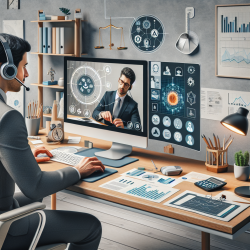Introduction
In the rapidly evolving landscape of remote work, speech-language pathologists (SLPs) are faced with unique challenges and opportunities. The research article "Remote Work in a Changing World: A Nod to Personal Space, Self-Regulation and Other Health and Wellness Strategies" offers valuable insights into optimizing remote work environments. This blog explores how SLPs can apply these findings to enhance their online therapy services, particularly in educational settings.
Cultivating Personal Workspace
Creating an effective personal workspace is crucial for maintaining productivity and focus during remote therapy sessions. The research highlights the importance of minimizing distractions, such as phone notifications and background noise, which can impede attention and task performance. SLPs should ensure their workspace is well-lit, ventilated, and free from interruptions to optimize their therapeutic interactions with children.
Building in Ergonomics
Ergonomics plays a vital role in preventing musculoskeletal issues and enhancing overall well-being. SLPs should invest in ergonomic office furniture, such as adjustable chairs and desks, to maintain proper posture during long therapy sessions. Regular breaks for physical activity can also mitigate the risks associated with prolonged sitting and improve mental clarity.
Boosting Self-Regulation Skills
Self-regulation is essential for SLPs to adapt to the demands of remote therapy. The ability to manage time effectively, set achievable goals, and stay motivated is critical for delivering high-quality services. Encouraging self-directed learning and continuous professional development can empower SLPs to refine their skills and remain responsive to the needs of their clients.
Conclusion
By integrating these data-driven strategies into their practice, SLPs can enhance their remote therapy services and create better outcomes for children. The emphasis on personal workspace, ergonomics, and self-regulation aligns with the broader goals of occupational health and safety, ensuring that both practitioners and their young clients thrive in the digital age.
To read the original research paper, please follow this link: Remote Work in a Changing World: A Nod to Personal Space, Self-Regulation and Other Health and Wellness Strategies.










